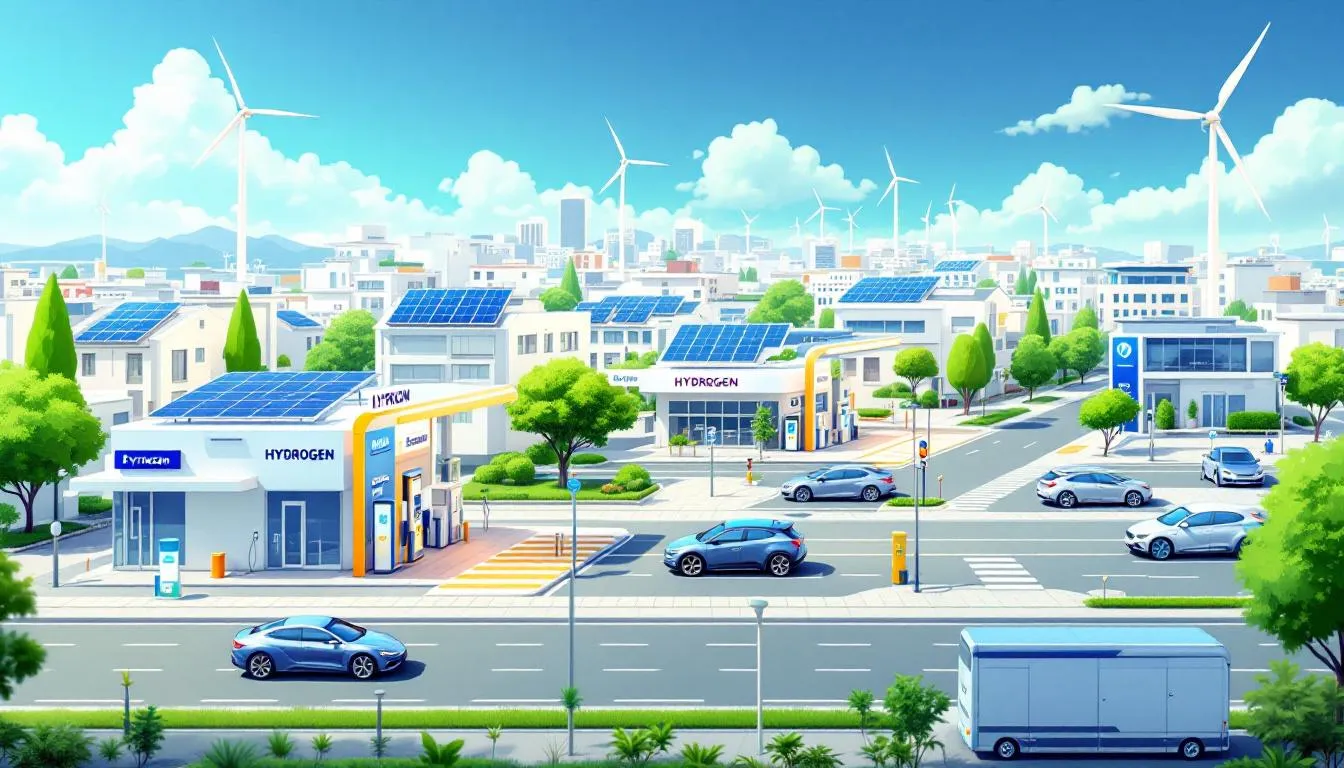
Renewable Energy Innovations – The Next Frontier in Green Power
As the climate crisis accelerates and the urgency to decarbonize deepens, innovations such as clean hydrogen are reshaping our global approach to power generation, sustainability, and infrastructure. While solar and wind power dominate today’s green landscape, the next transformative breakthrough is unfolding—hydrogen power.
Hydrogen, particularly green hydrogen, is emerging as a game-changer in the global energy transition, promising clean, efficient, and scalable energy solutions that can decarbonize hard-to-abate sectors, such as heavy industry, aviation, and long-haul transport. This blog post explores why hydrogen energy is considered renewable energy’s next frontier, diving deep into its potential, current progress, and the road ahead.
Understanding Hydrogen Power in the Context of Renewable Energy Systems
Hydrogen energy refers to the use of hydrogen gas (H₂) as a fuel source to generate electricity, power vehicles, and store energy. It can be used in fuel cells, where hydrogen reacts with oxygen to produce electricity, emitting only water vapor as a byproduct.
But not all hydrogen is created equal:
|
Type of Hydrogen |
Production Method |
Environmental Impact |
|---|---|---|
|
Grey Hydrogen |
From natural gas (methane) |
High CO₂ emissions |
|
Blue Hydrogen |
Grey hydrogen + carbon capture |
Lower CO₂, but not zero |
|
Green Hydrogen |
Electrolysis using renewable electricity |
Zero emissions |
Among these, green hydrogen stands out as the most sustainable and environmentally friendly, marking a significant milestone in clean energy innovation and aligning perfectly with the goals of a clean energy transition.
Read more on how green hydrogen works – IEA
Hydrogen explained – U.S. Energy Information Administration
Why Hydrogen is Renewable Energy’s Next Frontier
Despite its simple composition, hydrogen’s versatility is immense. Here’s why hydrogen is poised to be the next big leap in renewable energy innovation:
-
Energy Storage at Scale Hydrogen allows for long-duration energy storage, unlike lithium-ion batteries which are limited in capacity. It can store excess solar and wind energy during peak production and supply it back during low-generation periods.
-
Decarbonizing Heavy Industry Industries like steel, cement, and chemicals account for over 20% of global CO₂ emissions. Hydrogen can replace coal and natural gas in these processes, enabling deep decarbonization.
-
Clean Transportation Hydrogen-powered vehicles (FCEVs) offer longer ranges and faster refueling than traditional EVs, making them ideal for freight, buses, and aviation.
-
Energy Security & Independence By investing in domestic hydrogen production, countries can reduce dependence on fossil fuel imports and build resilient energy systems.
-
Integration with Existing Renewable Energy Projects Green hydrogen production facilities are now being integrated into solar parks and wind farms, maximizing renewable electricity utilization.
Global Hydrogen Projects Driving Sustainable Growth
Numerous countries are already investing billions in hydrogen infrastructure, guided by ambitious national strategies. Below are some noteworthy global hydrogen initiatives:
|
Country |
Hydrogen Strategy Highlights |
|---|---|
|
Germany |
€9 billion National Hydrogen Strategy, focus on green hydrogen export partnerships |
|
India |
National Green Hydrogen Mission to become a global hub for green hydrogen |
|
Australia |
Massive hydrogen hubs powered by solar/wind, targeting exports to Asia |
|
United States |
Hydrogen Hubs Program under the Inflation Reduction Act, with $8B in funding |
|
Japan |
Early leader in FCEVs, advancing hydrogen refueling networks and industrial use |
Explore the U.S. Hydrogen Energy Earthshot initiative
Technological Breakthroughs Fueling Hydrogen’s Rise
Recent years have seen rapid technological progress and advancements in hydrogen production, storage, and usage, making it increasingly cost-effective and scalable. Some of the key innovations include:
-
PEM (Proton Exchange Membrane) Electrolyzers: Faster, more compact, and efficient electrolyzers critical for green hydrogen production.
-
Solid Oxide Fuel Cells (SOFCs): Deliver high efficiency in electricity generation from hydrogen.
-
Ammonia Cracking Technology: Allows transport and conversion of hydrogen via ammonia, solving major storage and transportation challenges.
-
Advanced Hydrogen Storage Materials: Research in materials science is creating safer and denser hydrogen storage options.
Read how breakthroughs in electrolyzer technology are reducing hydrogen costs – BloombergNEF
Innovative hydrogen materials – ScienceDirect
Challenges and the Path Forward
Despite the enthusiasm, hydrogen energy faces several challenges before it can become mainstream:
-
High Production Costs: Green hydrogen is still more expensive than fossil fuels and grey hydrogen.
-
Infrastructure Gaps: Lack of pipelines, storage systems, and fueling stations remains a major bottleneck.
-
Energy Efficiency: Hydrogen involves energy losses in conversion and transport processes.
-
Policy Uncertainty: Inconsistent regulations and incentives slow down investment.
However, global efforts to address these hurdles are underway. International collaborations, carbon pricing mechanisms, tax credits, and public-private partnerships are helping de-risk hydrogen projects.
Read about hydrogen safety, infrastructure, and standards – Hydrogen Council
Global Hydrogen Review 2023 – IEA
Integrating Hydrogen into the Renewable Energy Infrastructure

As nations rapidly expand solar and wind energy projects, the intermittent nature of these renewable energy sources poses significant challenges to energy reliability and grid stability. This is where hydrogen plays a pivotal role. By integrating hydrogen production and storage technologies into renewable energy integration infrastructure, we can create a more flexible, resilient, and decarbonized energy system.
Power-to-Hydrogen Systems (P2H)
Power-to-Hydrogen (P2H) refers to using surplus renewable electricity (e.g., from solar or wind) to electrolyze water into hydrogen and oxygen. This process not only stores excess energy but also allows it to be reintroduced into the grid when needed—either through fuel cells or hydrogen combustion turbines.
This method significantly enhances the value of renewable electricity, transforming it into a storable, transportable fuel. It enables seasonal storage, helping bridge the gap between times of high energy production (like summer) and high energy demand (like winter).
Hydrogen as a Grid Balancing Tool
Hydrogen can also help with grid balancing and frequency regulation. When the grid has too much electricity, electrolysis units can absorb the surplus. When electricity is in short supply, hydrogen fuel cells can effectively meet energy requirements and dispatch power back into the grid—thereby maintaining grid stability and energy security.
This dual-direction integration is a breakthrough that makes renewable energy generation more consistent and reliable, particularly when scaled up with smart grid technologies and AI-driven demand forecasting.
Hydrogen Technologies Transforming Critical Sectors
Hydrogen is not just a power source—it’s a transformational enabler across multiple critical sectors that have historically relied on carbon-intensive fuels. Let’s explore how hydrogen technologies are providing innovative solutions and driving disruption and climate solutions across key areas.
Transportation Sector
-
Hydrogen Fuel Cell Vehicles (FCEVs) are gaining momentum alongside electric vehicles (EVs), especially for buses, trains, trucks, and ships, where battery weight and charging time pose limitations.
-
Leading companies like Toyota (Mirai) and Hyundai (NEXO) are already rolling out commercial hydrogen-powered cars.
-
In aerospace, companies like ZeroAvia are testing hydrogen-electric propulsion systems for regional flights.
Hydrogen and transportation – International Council on Clean Transportation
Industrial Applications
Industries such as:
-
Steelmaking: Using hydrogen direct reduction (H-DRI) instead of coal-based blast furnaces.
-
Ammonia and fertilizer production: Transitioning to green ammonia as both an input and export commodity.
-
Refining and petrochemicals: Replacing grey hydrogen with green alternatives.
These applications have the potential to cut gigatons of CO₂ emissions annually.
Power Generation and Backup Systems
-
Hydrogen turbines are being tested by companies like GE and Siemens for clean power generation.
-
Hydrogen is also used in remote backup power systems for data centers, hospitals, and telecom towers, where diesel is currently the norm.
Explore hydrogen in heavy industry – Mission Possible Partnership
Policy Support, Global Agreements, and Investment Trends
Accelerating the deployment of hydrogen-based renewable energy innovations requires substantial policy backing, financial incentives, and international collaboration to foster economic growth .
Key Policy Milestones and Incentives
-
Inflation Reduction Act (USA): Offers production tax credits for green hydrogen, making it cost-competitive with grey hydrogen.
-
EU Hydrogen Strategy: Sets a target of installing 40 GW of electrolyzer capacity by 2030.
-
India’s Green Hydrogen Policy: Offers free grid connectivity, land access, and waives inter-state transmission charges.
Full details of U.S. hydrogen incentives – Department of Energy
EU Hydrogen Strategy – European Commission
Rising Investment and Private Sector Involvement
According to BloombergNEF, over $500 billion is projected to be invested in the global hydrogen economy by 2030. Major players include:
-
Shell and TotalEnergies building hydrogen corridors.
-
Air Liquide and Linde investing in electrolyzer and refueling infrastructure.
-
Microsoft and Amazon piloting hydrogen backup systems in data centers.
Green hydrogen investment trends – BloombergNEF
Environmental Impact and Carbon Reduction Potential
Perhaps the most compelling case for hydrogen energy lies in its environmental sustainability. It directly contributes to:
-
Reducing greenhouse gas emissions from multiple sectors.
-
Improving air quality by eliminating particulate matter and NOx emissions from combustion engines.
-
Enhancing water conservation, especially with emerging technologies that use wastewater or seawater for electrolysis.
Here’s a quick comparison of emissions savings:
|
Sector |
Carbon Reduction Potential with Hydrogen |
|---|---|
|
Heavy Industry |
Up to 30–50% of current emissions |
|
Transportation |
Up to 20% of sectoral emissions |
|
Power Generation |
~10–15% (via grid balancing and storage) |
Hydrogen’s role in reducing GHG emissions – World Resources Institute
Conclusion – The Path to a Sustainable Future with Hydrogen Energy

The world stands at a pivotal moment in the global energy transition. With the growing urgency to combat climate change, reduce carbon emissions, increase energy access, and stabilize economies affected by fossil fuel volatility, renewable energy innovations are no longer optional—they are essential.
Among these innovations, hydrogen energy is proving to be the next frontier in green power. Its potential to store renewable energy, decarbonize critical sectors, and strengthen energy security makes it a cornerstone of the future renewable energy systems.
As governments, industries, and innovators accelerate progress on green hydrogen production, hydrogen fuel cells, and hydrogen infrastructure, we can expect to see:
-
Widespread adoption of hydrogen-powered transport across continents.
-
Integration of hydrogen technologies into both legacy and new energy infrastructure.
-
Declining costs due to technological breakthroughs and economies of scale.
-
A robust ecosystem of policy frameworks, global alliances, and public-private partnerships.
-
The rise of hydrogen-powered smart cities, industries, and carbon-neutral communities.
This is more than just a technological evolution—it is a paradigm shift toward a sustainable energy future that is clean, inclusive, and resilient. But success depends on continued innovation, long-term investment, and equitable global collaboration.
As we move forward, the words of Dr. Fatih Birol, Executive Director of the IEA, ring truer than ever:
“Hydrogen is today enjoying unprecedented momentum. The world should not miss this unique chance to make hydrogen an important part of our clean and secure energy future.“
Internal Links (For Deeper Engagement and SEO Optimization)
As part of the GoGreen Insights and NextGenTech Info ecosystem, explore more in-depth resources that complement this topic:
Final Thoughts: The Time is Now
From solar panels capturing sunlight to wind turbines harnessing gusts, the global push for clean energy is already underway. But to truly achieve a net-zero emissions world, we also need advancements in battery technology and hydrogen energy to play a central role in power generation, industrial processes, and transportation.
With the right mix of policy, technology, and collaboration, hydrogen will no longer be a future concept—it will be a present-day solution, driving sustainable growth, economic resilience, and planetary health.

https://shorturl.fm/rw7Yf